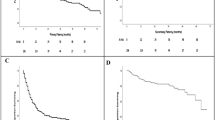Abstract
Purpose
This study was designed to evaluate the long-term patency rate and complications associated with early use of the autogenous forearm arteriovenous fistula (AFAVF) in patients needing urgent hemodialysis.
Methods
The clinical data of all patients undergoing AFAVFs for hemodialysis access between June 1996 and June 2016 were retrospectively evaluated. The primary and secondary patencies were estimated using the life table method.
Results
A total of 104 AFAVFs were created for 102 patients. All patients had entered hemodialysis when fistulas were constructed. The mean time to the first cannulation of the AFAVF was 17.33 ± 4.60 (5–27 days). Four AFAVFs (3.8%) became occluded within 30 days of creation of the access, and five AFAVFs (4.8%) had hematomas after cannulation. There were no cases of infection of the wound or steal syndrome or prolonged arm edema. The primary patency rate was 77.81% at 1 year, 73.05% at 2 years, 64.64% at 3 years, 60.75% at 5 years and 47.48% at 10 years. The secondary patency rate was 96.78% at 1 year, 95.18% at 5 years and 85.81% at 10 years.
Conclusions
In this study, the patency rates following the early use of the AFAVFs were not inferior to the previously reported patency rates in the literature. For patients entering hemodialysis with an inserted central catheter, the early use of the AFAVFs decreases the complications associated with catheters.


Similar content being viewed by others
References
Zhang L, Wang F, Wang L, Wang W, Liu B, Liu J, Chen M, He Q, Liao Y, Yu X, Chen N, Zhang JE, Hu Z, Liu F, Hong D, Ma L, Liu H, Zhou X, Chen J, Pan L, Chen W, Wang W, Li X, Wang H (2012) Prevalence of chronic kidney disease in China: a cross-sectional survey. Lancet 379:815–822. doi:10.1016/S0140-6736(12)60033-6
Rayner HC, Pisoni RL, Gillespie BW, Goodkin DA, Akiba T, Akizawa T, Saito A, Young EW, Port FK, Dialysis Outcomes and Practice Patterns Study (2003) Creation, cannulation and survival of arteriovenous fistulae: Data from the Dialysis Outcomes and Practice Patterns Study. Kidney Int 63:323–330. doi:10.1046/j.1523-1755.2003.00724.x
Vascular Access Work Group (2006) Clinical practice guidelines for vascular access. Am J Kidney Dis 48:S176–S247. doi:10.1053/j.ajkd.2006.04.029
Wong V, Ward R, Taylor J, Selvakumar S, How TV, Bakran A (1996) Factors associated with early failure of arteriovenous fistulae for haemodialysis access. Eur J Vasc Endovasc Surg 12:207–213
Saran R, Dykstra DM, Pisoni RL, Akiba T, Akizawa T, Canaud B, Chen K, Piera L, Saito A, Young EW (2004) Timing of first cannulation and vascular access failure in haemodialysis: an analysis of practice patterns at dialysis facilities in the DOPPS. Nephrol Dial Transplant 19:2334–2340. doi:10.1093/ndt/gfh363
Saran R, Pisoni RL, Young EW (2005) Timing of first cannulation of arteriovenous fistula: are we waiting too long? Nephrol Dial Transplant 20:688–690. doi:10.1093/ndt/gfh730
Robbin ML, Chamberlain NE, Lockhart ME, Gallichio MH, Young CJ, Deierhoi MH, Allon M (2002) Hemodialysis arteriovenous fistula maturity: US evaluation. Radiology 225:59–64. doi:10.1148/radiol.2251011367
Ohira S, Kon T, Imura T (2006) Evaluation of primary failure in native AV-fistulae (early fistula failure). Hemodial Int 10:173–179. doi:10.1111/j.1542-4758.2006.00091.x
Aitken EL, Stevenson KS, Gingell-Littlejohn M, Aitken M, Clancy M, Kingsmore DB (2014) The use of tunneled central venous catheters: inevitable or system failure? J Vasc Access 15:344–350. doi:10.5301/jva.5000206 (Epub 2014 Feb 10)
Malovrh M (2003) Approach to patients with end-stage renal disease who need an arteriovenous fistula. Nephrol Dial Transplant 18:v50–v52
Jemkov TK (2013) Morphological functional vessels characteristics assessed by ultrasonography for prediction of radiocephalic fistula maturation. J Vasc Access 14:356–363
Silva MB Jr, Hobson RW, Pappas PJ, Jamil Z, Araki CT, Goldberg MC, Gwertzman G, Padberg FT Jr (1998) A strategy for increasing use of autogenous hemodialysis access procedures: impact of preoperative noninvasive evaluation. J Vasc Surg 27:302–307
Ascher E, Gade P, Hingorani A, Mazzariol F, Gunduz Y, Fodera M, Yorkovich W (2000) Changes in the practice of angioaccess surgery: impact of dialysis outcome and quality initiative recommendations. J Vasc Surg 31:84–92
Fassiadis N, Morsy M, Siva M, Marsh JE, Makanjuola AD, Chemla ES (2007) Does the surgeon’s experience impact on radiocephalic fistula patency rates? Semin Dial 20(5):455–457. doi:10.1111/j.1525-139X.2007.00310.x
Van Gemert MJ, Bruyninckx CM (1987) Simulated hemodynamic arteriovenous fistulas. J Vasc Surg 6:39–44. doi:10.1067/mva.1987.avs0060039
Nakai S, Suzuki K, Masakane I et al (2010) Overview of regular dialysis treatment in Japan (as of 31 December 2008). Ther Apher Dial 14:505–540. doi:10.1111/j.1744-9987.2010.00893.x
Gulati S, Sahu KM, Avula S, Sharma RK, Ayyagiri A, Pandey CM (2003) Role of vascular access as a risk factor for infections in hemodialysis. Ren Fail 25:967–973
Dammers R, de Haan MW, Planken NR, van der Sande FM, Tordoir JH (2003) Central vein obstruction in hemodialysis patients: results of radiological and surgical intervention. Eur J Vasc Endovasc Surg 26(3):317–321
Akoh JA, Dutta S (2003) Autogenous arteriovenous fistulas for hemodialysis: a review. Niger Postgrad Med J 10:125–130
Radoui A, Lyoussfi Z, Haddiya I et al (2011) Survival of the first arteriovenous fistula in 96 patients on chronic hemodialysis. Ann Vasc Surg 25:630–633. doi:10.1016/j.avsg.2010.08.011
Author information
Authors and Affiliations
Corresponding author
Ethics declarations
Conflict of interest
The authors declare that they have no conflict of interest.
Ethical approval
All procedures performed in studies involving human participants were in accordance with the ethical standards of the institutional and/or national research committee and with the 1964 Helsinki declaration and its later amendments or comparable ethical standards.
Informed consent
Informed consent was obtained from all individual participants included in the study.
Rights and permissions
About this article
Cite this article
Ren, W., Jiang, H., Du, Y. et al. Early use of autogenous arteriovenous fistula in patients with urgent hemodialysis. Int Urol Nephrol 49, 1087–1093 (2017). https://doi.org/10.1007/s11255-017-1557-3
Received:
Accepted:
Published:
Issue Date:
DOI: https://doi.org/10.1007/s11255-017-1557-3




